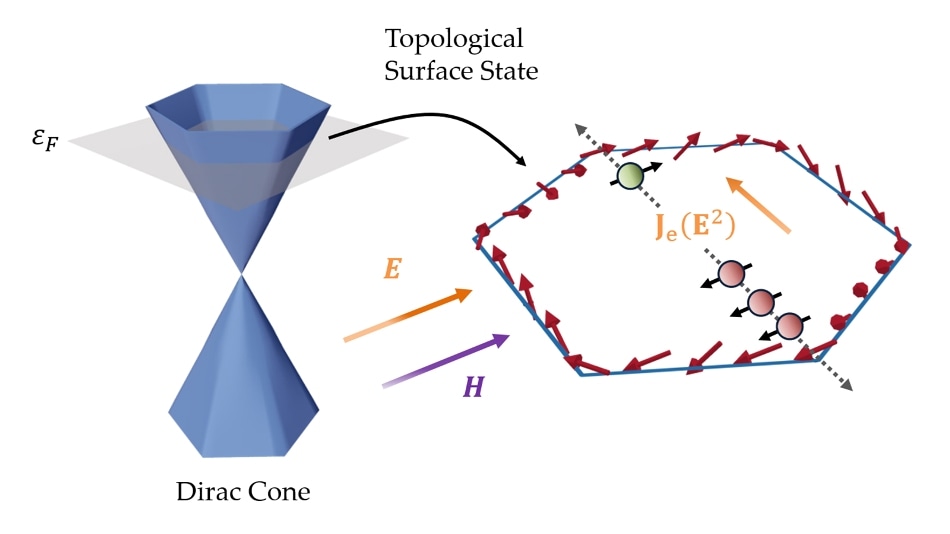Sep 11 2019
Some materials, such as copper, are good conductors of electricity. However other materials, such as glass, are poor conductors. A specific type of material, known as a topological insulator, behaves as a conductor at its surface and as an insulator in its interior.
 The specific relation between electronic states in a topological insulator and momentum leads to an asymmetric accumulation of spin, depicted on the right, which gives rise to an electric current to second order in an applied electric field E. (Image credit: Shulei Zhang/Argonne National Laboratory)
The specific relation between electronic states in a topological insulator and momentum leads to an asymmetric accumulation of spin, depicted on the right, which gives rise to an electric current to second order in an applied electric field E. (Image credit: Shulei Zhang/Argonne National Laboratory)
Topological insulators possess exclusive electronic properties and can potentially be used in spintronic devices, or even possibly as transistors for quantum computers. Therefore, researchers at the U.S. Department of Energy’s (DOE) Argonne National Laboratory have shown interest in analyzing the unique relationship between two properties of the conducting surface electrons in such materials.
In the case of topological insulators, the momentum and spin of each surface electron are so closely linked that, in scientific terms, they are locked to one another.
Spin-momentum locking is like having a basketball that must rotate in a specific direction depending on its trajectory down the court. Because an electron also carries a magnetic moment, you can use spin-momentum locking to manipulate magnetic systems very efficiently.
Olle Heinonen, Materials Scientist, Argonne National Laboratory
The topological insulators’ electronic structure, including the particulars of spin-momentum locking, may be revealed by the electron transport behavior in these materials. In order to investigate the unique behavior of electrons in such materials, Argonne researchers worked with researchers at the National University of Singapore, who conducted a transport experiment that offered a novel view of the topologically protected electronic structure.
Heinonen and Shulei Zhang, former Argonne postdoctoral researcher, elucidated how, in the transport experiment, a magnetic field applied along the plane of a thin film of a topological insulator had the ability to produce a voltage in the direction perpendicular to the applied electric current—a phenomenon known as a nonlinear planar Hall effect.
By changing the magnetic field’s intensity and direction, the Argonne scientists and their collaborators could use the resulting resistance information to determine how the electrons are distributed based on their spin and momenta.
If you know how magnetic fields applied in different directions would affect the nonlinear Hall current measured, you can use our theoretical model to map out how the electrons’ momenta and spins are distributed. Then, because of the way we can see more precisely how the electromagnetic fields interact with the surface conduction electrons, we can get much more detailed information of the surface electronic structure of topological insulators.
Shulei Zhang, Former Postdoctoral Researcher, Argonne National Laboratory
In the words of Heinonen, the relation between the topological surface states with spin-momentum locking and the nonlinear planar Hall effect is a “macroscopic-microscopic relationship.”
“It really gives us a look under the hood,” he added.
A paper based on the research, titled “Nonlinear planar hall effect,” was published in the online edition of Physical Review Letters, dated July 1st, 2019.
Scientists from the University of Missouri also contributed to the study.
The DOE’s Office of Science (Office of Basic Energy Sciences) funded this study.